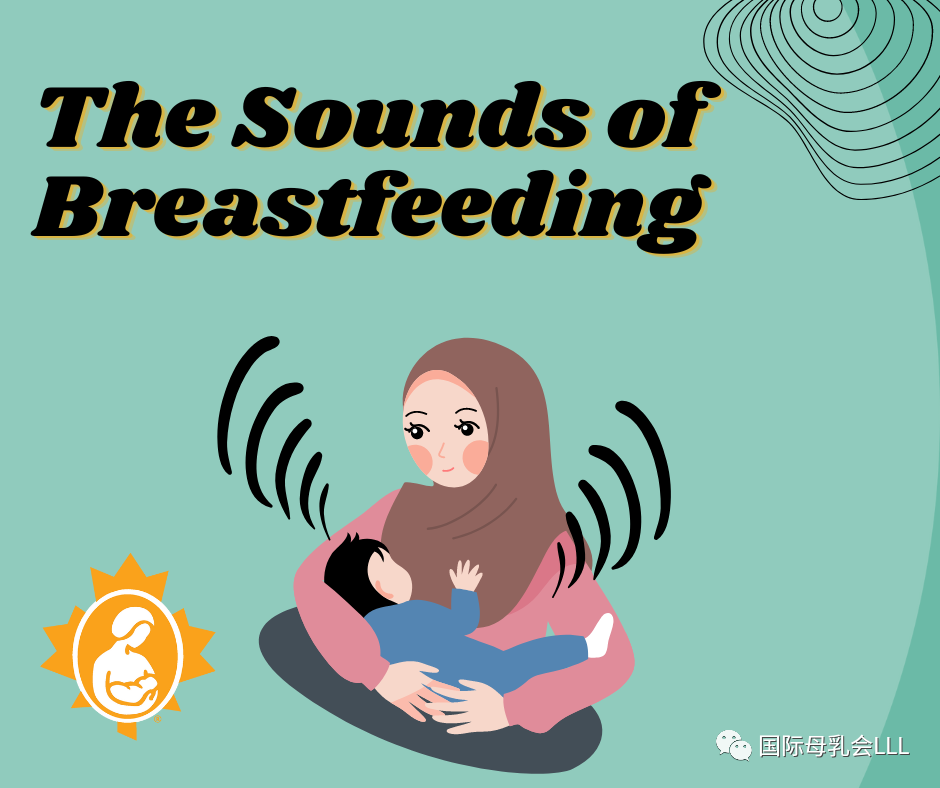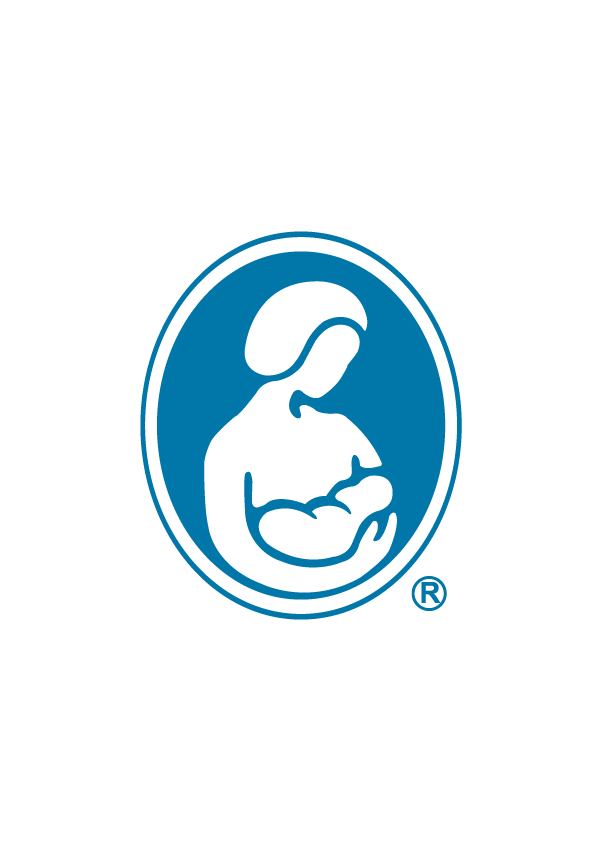点击上方 国际母乳会LLL 设为星标 ,获取哺乳信息

新手父母听到婴儿吃母乳时发出的声音,往往会很惊讶。母乳喂养和育儿的书里通常不会提到这些声音。图片是无声的,而许多准父母也从来没有和母乳宝宝相处过。那么,哺育之音是什么样的呢,它又告诉了我们什么?
产后第三到五天,你的母乳量虽少,但正好匹配婴儿的小胃口。婴儿可能要吸吮好几次,你才会听到一次吞咽声。随着母乳量的增加,婴儿会在每次开始吃奶时快速地吸吮以刺激奶阵(即喷乳反射)。
一旦乳汁开始流出,婴儿一般会每吸吮一两次,就吞咽一次。每次吸吮都能喝到一大口奶的婴儿,会随着每次的吞咽发出轻微的吸气声。有时声音太轻了很难听到。吞咽后,婴儿会呼出一口气,听起来像“咔”声。呼气后,婴儿会再次吸气和吞咽,如此循环往复。
当喷乳反射很强时,婴儿会以规律地吞咽或发出“咔”声的方式来吸吮–吞咽–呼吸、吸吮–吞咽–呼吸。
有时你会听到“咔哒”声。随着每次吸吮婴儿脸颊上可能还会出现明显的酒窝,也可能没有。你的乳头也可能疼痛。
这些迹象,无论是一同还是单独出现,都可能表明你的婴儿含乳不够深。“咔哒”声说明婴儿破坏了在乳房上形成的密闭性,这会导致乳头在他嘴里滑动,往往就造成了乳头疼痛。
如果你听到了“咔哒”声,就试着将婴儿的下巴紧贴到乳房上来改善含乳。婴儿的头向后仰时,鼻子应该上仰离开乳房。鼻子往往会碰触乳房,但不应埋进去。你不应该觉得必须得向后按住乳房,婴儿才能够呼吸。
母乳喂养中的常见声音:
感谢提供母乳喂养音频的妈妈们!
下巴紧贴住、鼻子向上仰、头往后仰,这就和你喝水时的姿势一样。(现在就来试试,假装喝水。看看你的下巴是如何往前伸,头是如何向后仰的?)
当你觉得婴儿含乳不佳时,立即纠正非常重要。如果感觉疼痛,你就得让婴儿松开乳房,可以把一根手指塞入他的嘴角来中断吸吮,然后试着重新含乳。也可以在婴儿含着乳头的同时调整含乳姿势,如果婴儿的下巴缩到她胸前,是无法用嘴含住乳房的,吞咽也很困难。(现在就试试吧,你把下巴缩到胸口然后吞咽,很难吧!)
你可以试着调整婴儿的姿势,让她的下巴紧贴着你的乳房,头向后仰。用这种姿势,婴儿就可以舒服地吃奶了,就像你喝水一样。
如果“咔哒”声、婴儿脸颊上的酒窝或你的乳头疼痛一直存在,请联系国际母乳会哺乳辅导或国际认证哺乳顾问(IBCLC),检查一下含乳是否有问题。
大多数情况下,调整适合你和婴儿的哺乳体位就能很快解决问题。如果有持续的乳头疼痛或含乳不佳,可能需要进一步检查,以确保婴儿没有舌系带/唇系带过紧或其它问题。
你可能听到一些声音像是乳汁喷到婴儿喉咙后方,或像是喷乳反射时婴儿来不及喝奶。有些母亲的喷乳反射很强烈,这就是说婴儿每次吸吮都能吃到大量的奶。新生儿可能很难对付这么大量的乳汁,会让他在乳汁流速最快时松开乳房。
你可以调整一下姿势,向后斜躺着,让婴儿趴在乳房上,就能帮助控制乳汁的流速。如果遇到这种情况,国际母乳会哺乳辅导也可以帮你和婴儿找到最佳的哺乳姿势。
有时婴儿会发出呼噜声,或是刺耳吱吱作响的呼吸声。这些声音可能没有问题,但你应和医护人员或国际认证哺乳顾问(IBCLC)讨论一下。
最重要的是要记住,母乳喂养是不应该痛的。如果你感到乳头疼痛,肯定有什么地方不对,不管外表看起来含乳有多好。
接下来要考虑的是,婴儿大小便的尿布数量是否在他这个月龄是够的,还有体重增长得是否合适。更多的相关信息,请参阅《如何知道婴儿是否吃到了足够的母乳》。
如果你乳头不痛,婴儿也长得很好,那么哺乳时的声音就只是一些有趣之音,试着享受其中吧。
更新于2022年
你可能也感兴趣的相关信息:

DECEMBER



The Sounds of Breastfeeding

First time parents are often surprised by the feeding noises that come with breastfeeding a baby. Breastfeeding and parenting books don’t usually mention these sounds. Photos are silent and many expectant parents have never spent time with a breastfeed baby. So, what are the sounds of breastfeeding and what do they tell us?
In the first three to five days your milk volume is small to match your baby’s small tummy size. Your baby may suck several times before you hear a swallowing sound. As the milk volume increases your baby will suck rapidly at the beginning of each feeding to trigger the letdown of your milk (milk ejection reflex). Once your milk starts flowing, your baby will usually suck once or twice for each swallow. A baby who is getting a good mouthful of milk with each suck makes a small gulping noise with each swallow. This is sometimes too quiet to hear. After swallowing, your baby will breathe out with a puff of air that sounds like a “k-ah” sound. After breathing out (exhaling) your baby will breathe in and swallow again, repeating the cycle. When your milk is letting down strongly, your baby will suck, swallow, breath, suck, swallow, breathe in a rhythmic gulp/”k-ah” pattern.
Sometimes you may hear a “clicking” sound. Your baby may or may not also have noticeable dimples in the cheeks with each suck. And you may have sore nipples. These signs, together or individually, may suggest that your baby has not achieved a deep latch. A “click” indicates that your baby is breaking the seal on the breast. This causes your nipple to slip in your baby’s mouth and often creates a sore nipple. If you are hearing clicking, try improving the latch by bringing your baby’s chin deeply onto your breast. Your baby’s nose should tilt away from the breast as your baby’s head tips back. The nose often touches the breast but it shouldn’t be poking into it. You shouldn’t feel like you have to hold your breast back so your baby can breathe. Chin in, nose tilting away, head back is the same position you take when you drink something. (Try it now, pretend to take a drink of water. See how your chin goes forward and your head tips back?)
When you feel that your baby is not latched well, it is important to deal with it right away. If it feels painful you may have to unlatch your baby from the breast by slipping a finger in the corner of her mouth to break the suction. Then you can try latching again. However, usually the latch can be adjusted while your baby is still latched. If your baby’s chin is tucked into her chest, she will not be able to hold onto the breast with her mouth. She will have difficulty swallowing. (Try it now. Tuck your chin into your chest and swallow. It is very hard.) You can try adjusting your baby so that her chin presses into your breast and her head tips back. In this position your baby can drink comfortably, just like you do.
If the clicking, dimpling or sore nipples persist, contact a La Leche League Leader or an International Board Certified Lactation Consultant (IBCLC) to review your latch. In most cases, an adjustment to the positioning fit between you and your baby quickly resolves the problem. Persistent soreness or poor latch may need further investigation to ensure that your baby does not have a tongue or lip tie or some other issue.
You may hear something that sounds like your milk is hitting the back of your baby’s throat, or like your baby is drowning when your milk lets down. Some mothers have a strong milk ejection reflex. This means that your baby can get a lot of milk with each suck. Your newborn may find this amount of milk hard to handle. This may make your baby pull away from the breast when the flow is strongest. Adjusting your position so you are laying back with your baby on top of your breast can help manage the milk flow. This is another situation in which a La Leche League Leader can help you work out the best positioning for you and your baby.
Sometimes babies make grunting noises or have raspy or squeaky breathing. These sounds may be fine but you should discuss with your healthcare provider or International Board Certified Lactation Consultant (IBCLC).
The most important thing to remember is that breastfeeding should not be painful. If you are experiencing nipple pain something is not right, no matter how good the latch looks from the outside. The next thing to consider is whether or not your baby is producing adequate wet and poopy diapers for his age and is gaining weight appropriately. See How to Know Your Baby is Getting Enough Milk for more information.
If you are pain free and your baby is growing well then the noises of breastfeeding are just funny noises and you will probably learn to love them.
Updated 2022

reference resources
参考资源
www.lllc.ca/sounds-breastfeeding

END
译者 | Lynn
审阅 | 传艳、张楠、Victoria
视频 | 黄明珠
编辑 | 李热爱


更多阅读资料,
欢迎大家访问“国际母乳会LLL”官网:
https://www.muruhui.org/
分享
收藏
点赞
在看

本篇文章来源于微信公众号: 国际母乳会LLL
